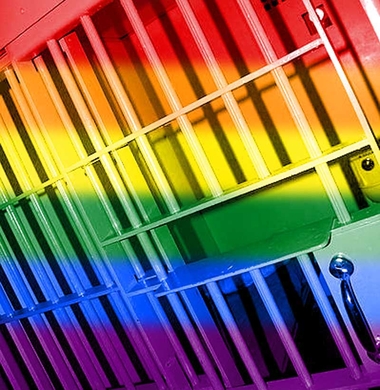Unjust criminal justice: LGBT immigration

Pt. IV: An Unjust Criminal Justice System
In the System
LGBT youth and adults are disproportionately targeted by the criminal justice system and are thus subjected to unfair convictions, physical and emotional abuse and a lack of medical care when in the system.
Section 2 of Unjust: How the Broken Criminal Justice System Fails LGBT People takes us on a walk through In the System: LGBT people are more frequently incarcerated and treated harshly (Center for American Progress, Movement Advancement Project). Two subjects will be covered in the next two weeks – discrimination in legal proceedings and unfair and inhumane treatment in jails, prisons and other confinement facilities – and today we will be introducing the subject of being in the system.
Between 12 and 20 percent of youth in juvenile justice facilities are LGBT youth, which is an astounding amount compared to the national average of LGBT-identified youth. As for adults, two reports by the federal Bureau of Justice Statistics found that 8 percent of adults in the prison system identify as LGBT, compared to the national average of 3.4 percent. That is more than twice the amount!
According to Unjust and the National Transgender Survey, one in six (16 percent) transgender people have experienced at least one period of incarceration. The rates only increase when specified. Black transgender people have experienced this at a whopping 47 percent and transgender women at 21 percent. Transgender veterans are also twice as likely to be involved in the unjust criminal justice system than non-trans veterans.
“These high rates of incarceration for transgender people come despite the fact [that] they have higher rates of education than the general incarcerated population,” Unjust says.
Rates shoot higher for LGBT undocumented immigrants, Unjust continues. “There are an estimated 267,000 LGBT-identified undocumented individuals in the United States. It is likely that LGBT people are overrepresented in immigration detention because of the number of LGBT people who come to the United States to seek asylum based on persecution in their home countries based on their sexual orientation, gender identity, and/or HIV status. There are an additional 637,000 LGBT-identified documented immigrants, including those with green cards.”
It is said that a quarter of the world’s prison population is held in U.S. prisons and jails. In addition to this staggering statistic, the United States only comprises of 4.4% of the world’s total population.
Minors who are placed in a juvenile justice facility to await adjudication are judged by the severity of their crime, their arrest record, their family status and school grades (or lack of schooling). After tried in juvenile court, some are moved into the adult criminal justice system.
“In 2011, there were 41,934 young people in juvenile justice facilities. Many juvenile residential facilities are overcrowded, particularly publicly run facilities, exacerbating existing flaws in the way young people are treated in the system,” Unjust says. “Extensive research shows that these facilities do not meet the needs of youth and do little to ensure their safety and well-being or to provide effective services to help youth when they are released.”
Aside from adult prisons and juvenile detention centers, there are the immigration detention facilities, which hold about 440,600 in the course of a year. Immigration and Customs Enforcement (ICE) detention facilities detain illegal immigrants and act as a purgatory of sorts – they hold those awaiting a determination of whether they will stay in the States or be deported.
“Unauthorized” or “undocumented” immigrants are subject to deportation. These amount to approximately 11.4 million people in the U.S. “Of these, there are 267,000 LGBT undocumented immigrants in the United States, 71 percent of whom identify as Hispanic. Additionally, there are an estimated 637,000 documented LGBT immigrants, 30 percent of whom are Hispanic” (Unjust).
According to research, undocumented LGBT immigrants face high rates of poverty, bigger families with more children and are younger than the general population. They especially experience higher rates of hate crimes and violence than the total LGBT population.
“Given heightened policing of immigrants, people of color, and LGBT people, LGBT immigrants, particularly LGBT immigrants who are also people of color, are more likely than the broader population to be targets of law enforcement. These interactions with police can result in the detention and deportation of LGBT immigrants, many of whom are returned to countries where they can face discrimination, persecution, and even death” (Unjust).
Those who enter the United States seeking asylum are avoiding persecution in their countries of origin. There are countless places where LGBT people are not safe to reside just because of who they are. As a result of legal consequences in foreign countries and in the U.S., LGBT immigrants may not come “out” to their families and friends for fear of further persecution. This leads to a detrimental life for those who are closeted and seeking asylum. And, many asylum seekers see this as a reason not to ask the government for help when they are struggling to make ends meet.
Discrimination in legal proceedings will be the topic covered next week in In the system: LGBT people are more frequently incarcerated and treated harshly from Unjust: How the Broken Criminal Justice System Fails LGBT People.
The Gayly - 3/28/2016 @ 12:30 p.m. CST





